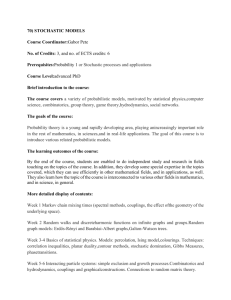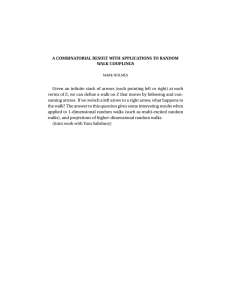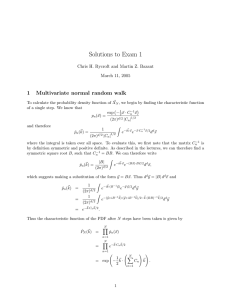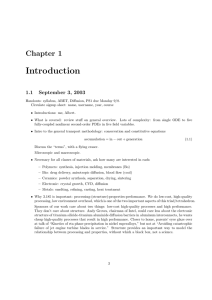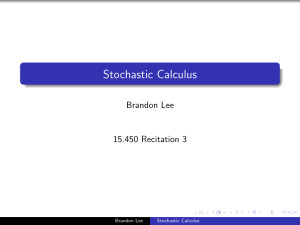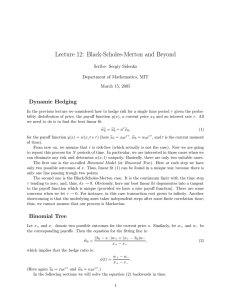Lecture 13: Discrete and Continuous ... Discrete Markov Processes Scribe: Sergiy Sidenko
advertisement
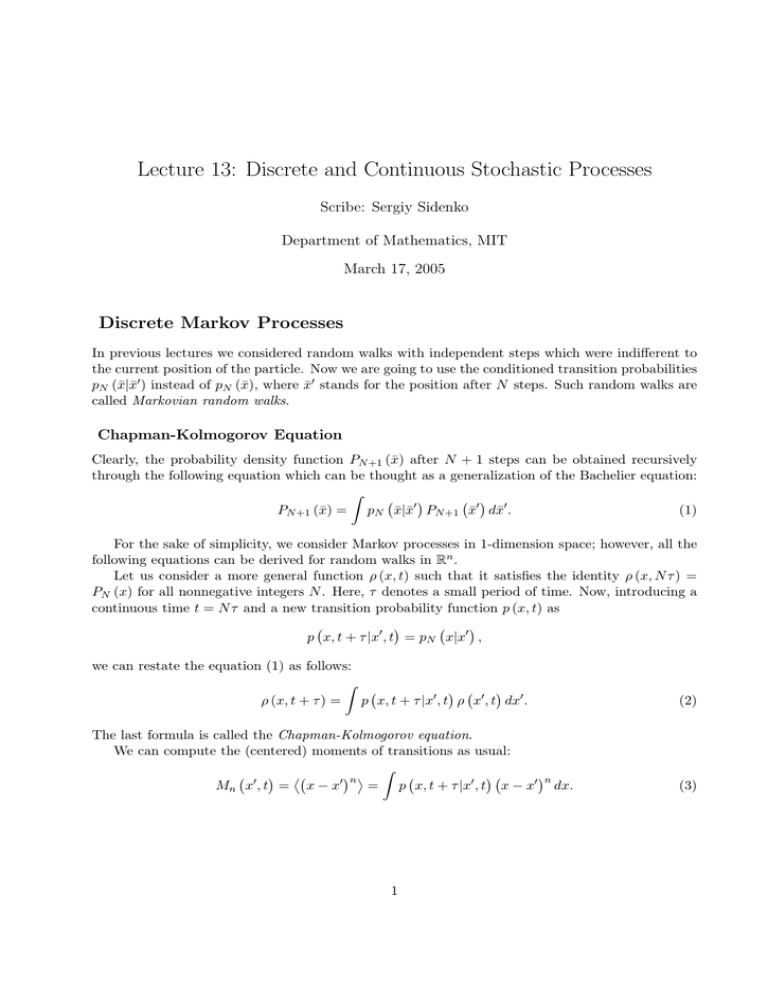
Lecture 13: Discrete and Continuous Stochastic Processes Scribe: Sergiy Sidenko Department of Mathematics, MIT March 17, 2005 Discrete Markov Processes In previous lectures we considered random walks with independent steps which were indifferent to the current position of the particle. Now we are going to use the conditioned transition probabilities pN (¯|x x ¯� ) instead of pN (¯ x), where x ¯� stands for the position after N steps. Such random walks are called Markovian random walks. Chapman­Kolmogorov Equation Clearly, the probability density function PN +1 (x̄) after N + 1 steps can be obtained recursively through the following equation which can be thought as a generalization of the Bachelier equation: � � �� � �� � PN +1 (¯ x) = pN x|x ¯ ¯ PN +1 x ¯ d¯ x. (1) For the sake of simplicity, we consider Markov processes in 1­dimension space; however, all the following equations can be derived for random walks in Rn . Let us consider a more general function ρ (x, t) such that it satisfies the identity ρ (x, N τ ) = PN (x) for all nonnegative integers N . Here, τ denotes a small period of time. Now, introducing a continuous time t = N τ and a new transition probability function p (x, t) as � � � � p x, t + τ |x� , t = pN x|x� , we can restate the equation (1) as follows: � � � � � ρ (x, t + τ ) = p x, t + τ |x� , t ρ x� , t dx� . (2) The last formula is called the Chapman­Kolmogorov equation. We can compute the (centered) moments of transitions as usual: � � � � �� � � � �� �n � n Mn x , t = x − x = p x, t + τ |x� , t x − x� dx. (3) 1 M. Z. Bazant – 18.366 Random Walks and Diffusion – Lecture 13 2 Kramers­Moyall Expansion In this section we will obtain formally a PDE for the function ρ (x, t) as N tends to infinity. Let us introduce a new variable y = x − x� . Then, (2) can be rewritten as follows: � ρ (x, t + τ ) = p (x + y − y, t + τ |x − y, t) ρ (x − y, t) dy. Now assuming that all moments Mn (x� , t) are finite for all x and t, we expand the right­hand side (here we use the fact that M0 ≡ 1) and integrate each term separately: � n=∞ � (−y)n ∂ n ρ (x, t + τ ) = [p (x + y, t + τ |x, t) ρ (x, t)] dy n! ∂xn = n=0 ∞ n= � n=0 (−1)n ∂ n [Mn (x, t) ρ (x, t)] . n! ∂xn Since the first term in the right­hand side is merely ρ (x, t), we can rewrite the last formula as follows: ρ (x, t + τ ) − ρ (x, t) τ = n=∞ � τ n−1 ∂ n ρ ∂ρ + ∂t n! ∂tn (4) n=2 = n=∞ � n=1 (−1)n ∂n [Dn (x, t) ρ (x, t)] , ∂xn (5) (x,t) where Dn (x, t) = Mnn!τ . Note that we can apply this approach only in the ‘central region’, but not in ‘tails’ of the Green function G (x, t|x0 , 0) which solves the PDE with the initial condition ρ (x, 0) = δ (x − x0 ). Now we are able to do two things: either to get (by recursive substitution) a valid asymptotic expansion of ρ (x, t) as N tends to infinity with t fixed, or to consider the limit with τ → 0 assuming some scaling for Mn (x, t). It turns out that these two methods are not equivalent. Modified Kramers­Moyall Expansion In the first approach mentioned above we have: ∂ρ ∂t ∂ ∂2 ∂3 ∂4 (D1 ρ) + 2 (D2 ρ) − 3 (D3 ρ) + 4 (D4 ρ) ∂x � ∂x ∂x � ∂x �� ∂ ∂2 τ ∂ ∂D1 ρ + D1 − (D1 ρ) + 2 (D2 ρ) 2 ∂x ∂t ∂x ∂x � � �� 2 ∂ ∂2 ∂D2 τ ∂ (D1 ρ) + 2 (D2 ρ) + . . . . ρ + D2 − 2 ∂x2 ∂t ∂x ∂x = − + − Now assuming that all Dn are constants, we arrange all terms depending on the orders of partial space derivatives: � � ∂ ∂2 τ ∂ ∂ ∂ρ =− (D1 ρ) + 2 (D2 ρ) − (D1 ρ) + . . . , D1 ∂x ∂x 2 ∂x ∂x ∂t M. Z. Bazant – 18.366 Random Walks and Diffusion – Lecture 13 3 which can be rewritten as follows: τ � ∂2ρ ∂ρ � σ2 ∂ 2ρ = D2 − D12 = , ∂t 2 ∂x2 2τ ∂x2 where σ 2 = M2 − M12 is the variance of the displacements, not the second moment, as expected from the Central Limit Theorem. If we want to consider the limit with τ → 0, we clearly should omit the terms with τ . Continuous Stochastic Processes Fokker­Planck Equation Let us now consider the second approach, namely, τ → 0. Assume that all moments scale (for all x and t) as in the Central Limit Theorem: M1 , M2 = O (τ ) , � � Mn = O τ n/2 if n > 2. With these scalings, the expansion (4) is asymptotic to O (τ ) and the leading order equation gives us the Fokker­Planck equation: ∂ρ ∂ ∂2 + (D1 ρ) = (D2 ρ) , ∂τ ∂x ∂x2 (6) where M1 (x, t) , τ →0 τ M2 (x, t) D2 (x, t) = lim . τ →0 2τ D1 (x, t) = lim Stochastic Differential Equations Let us consider the following continuous­time stochastic process: �t xt = dxt , (7) 0 where dxt = a (xt , t) dt + b (xt , t) dz. (8) In (8) a (xt , t) denotes the mean drift of the process, b (xt , t) represents the variant rate and dz stands for so­called Wiener’s Stochastic differential. The integral of dzt � zt = dzt (9) generates Wiener process, or Brownian motion. By assumption, we have the following properties of dzt : < dzt > = 0, < dżt > = dt. M. Z. Bazant – 18.366 Random Walks and Diffusion – Lecture 13 4 One (perhaps, the most intuitive) way of thinking about dzt is to consider it as an infinitesimal Gaussian displacement. As we see, by construction the probability density function of xt exactly satisfies the Fokker­ Planck equation with D1 (x, t) = a (x, t) , b2 (x, t) D2 (x, t) = . 2 Itô calculus It turns out that the ordinary rules for differentiation are not applicable if we want to find the derivative of f (xt , t), where xt is defined as in (7). The famous Itô’s Lemma says that in fact the differential of f can be found as follows: � � � � ∂f ∂f b2 ∂ 2 f ∂f df = +a + dt + b dz. (10) ∂t ∂x 2 ∂x2 ∂x √ The intuition behind the additional terms is that dxt is actually of order dt; thus, we must carry extra terms to keep the right­hand side of order dt. Application in Finance In the ‘Black­Scholes world’ we might have the following ‘geometric Brownian motion’ (or lognormal process) dxt = µxdt + σxdz = x (µdt + σdz) , where σ is the volatility and µ is the expected rate of return. Thus, the corresponding process xt depends only on two quantities: µ and σ. If we consider, for instance, the function y = log x, then the Itô’s lemma gives us for dy: � � σ2 dy = µ − dt + σdz = µdt ¯ + σdz. 2 � � 2 Therefore, drift in x = ey is µ ¯ + σ2 x, and: � Δx x � =µ ¯+ σ2 , 2 which corresponds to the earlier obtained formulas. Let us now apply Itô’s lemma to the hedged portfolio u = w − φx, where w is the option price and φ = ∂w ∂x (11) is the hedge ratio. Formula (10) gives us: du = dw − φdx − xdφ − dxdφ = dw − φdx − (x + dx) dφ. The last term here represents investing money right after the time step at t, because x + dx is a new price and dφ is a change in the asset. Since in practice nobody wants to be bound to M. Z. Bazant – 18.366 Random Walks and Diffusion – Lecture 13 5 invest money in the same asset (we might want to do something else with this money), the term (x + dx) dφ is neglected. Another reason for this is that nobody wants to link future investments to the profit gained at time t. After that we have: du = dw − φdx � � � � � � ∂w ∂w σ 2 x2 ∂ 2 w ∂w ∂w = + µx + dt + σx dz − (µxdt + σxdz) . ∂t ∂x 2 ∂x2 ∂x ∂x Here the term with dz drops out and we have no risk dependence in the equation. Also, mean return µx ∂w ∂x is canceled, and we obtained � du = � ∂w σ 2 x2 ∂ 2 w + dt. ∂t 2 ∂x2 Now we want u to grow at rate r which is the risk free rate. Thus, we must claim that du = rudt. Substituting w − φx for u and � ∂w ∂x for φ, we get the Black­Scholes equation : ∂w σ 2 x2 ∂ 2 w + ∂t 2 ∂x2 � � � ∂w dt = r w − x dt ∂x ∂w ∂w σ 2 x2 ∂ 2 w + rx + = rw. ∂t ∂x 2 ∂x2 (12)
